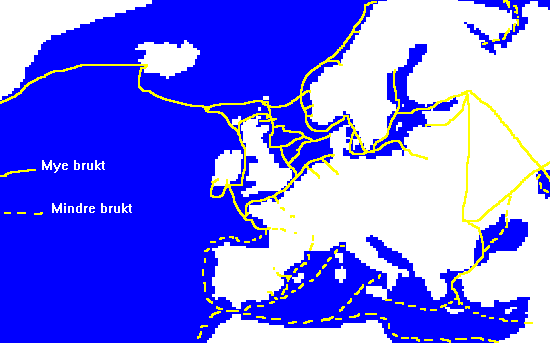The Norsemen were well known in northwestern Europe as peaceful and respectable traders, at least for several hundred years prior to 800AD. But in the late 700's this peaceful activity evolved into plundering raids instead. The Vikings started to attack and plunder monasteries, towns and areas along coastlines. In the year 793 they attacked the Lindisfarne monastery and in the following year the Jarrow monastery.
Many theories have been launched concerning why the Vikings started with the plundering raids. Since the 1930's, recommended books studying this question have maintained that over population was responsible for this activity. Later, this theory was supplemented with an explanation to the effect that there was also a spirit of adventure and a need for discovery.
Torgrim Titlestad, while discussing the issue in a recent book
that the Danes had built in southern Denmark. In other words, the attacks the Vikings visited upon the monasteries were not to terrorize defenseless monks, but to fight back a constant threat from the more barbarian Christian Church.
The two systems had values, religious beliefs, legal systems and power bases which were inconsistent with each another. The Vikings defended their system of small kingdoms for a long time against the centralized power of the Church in the south. However, in the latter part of the 700's the balance of power changed. The rule of the Franco king, Charlamange (Karl the Greate) , was in decline, while the Scandinavian chieftains had prospered sufficiently to take up arms and fight back. Also, the Vikings had developed the Viking ships. At the time, these ships were a supreme weapon, which they knew how to use to full advantage.
In the beginning, the Viking raiding groups were small. The first raid we know about involved only three ships crossing the sea. In the year 836 the number of ships rose to 25, and in the years 850 - 851 there were 350 ships reported on the river Thames near London. According to written records, the first time the Vikings spent the winter abroad was during the years 840 -841 in Ireland. In the year 843 the also spent the winter in France.
The Vikings had a good nose for tactics. They struck where their effort would be most profitable, such as during times of political disharmony. For example when the son of Charlamange (Karl the Greate) ascended to the throne of France the Vikings used the opportunity to attack. Then, when the emperor managed to raise an army against the Vikings in the 830's, the Vikings left France and began to plunder England again.
Later, when a period of political turmoil beset France, the Vikings returned and continued to ravage the area for another twenty years. In the year 865 they left France and went to England, attacking East Anglo and taking custody of the dominion of York. On the other hand, the attack made upon Wessex was struck down, whereupon King Alfred secured a treaty forcing the Vikings to make an annual payment while also prohibiting them from making further attacks.
However, it is difficult to make a clear distinction between a traditional Viking raid, a plundering tour, a trading tour, an act of defense against Christianity or the desire to acquire new land. These acts often had overlapping motives. But the typical aim of the Vikings in preying upon others was to capture prisoners for a ransom. It also appears that they favored kidnapping members of the upper class in order to be able to bargain for more goods. If the ransom was not paid, the prisoner was taken away and sold as a slave in another area. The Viking usually established a base on island in the area they had decided to raid. They would bring their booty to this base - most often only prisoners of war. From this island base they would bargain over the prisoner's head. Slave trading was a big business in the areas the Vikings visited.
An overview made by Pierre Barthélemy
(Les Vikings, Paris, 1988 ) 